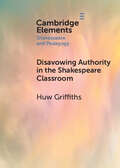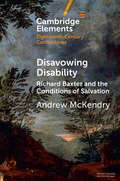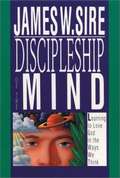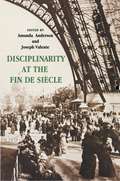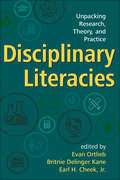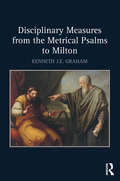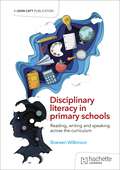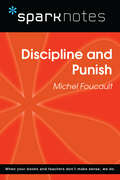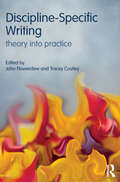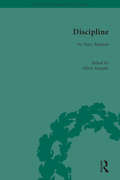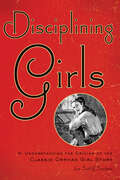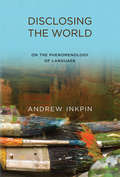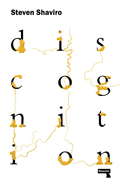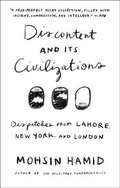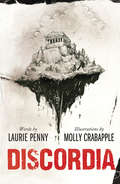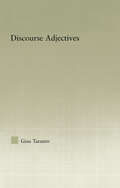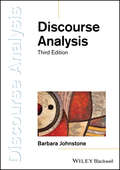- Table View
- List View
Disavowing Authority in the Shakespeare Classroom (Elements in Shakespeare and Pedagogy)
by Huw GriffithsBased on real experiences of teaching Shakespeare in diverse classrooms and outreach programmes, this Element questions the role of authority in Shakespeare teaching. It connects an understanding of how Shakespearean texts function with critical thinking about teaching, especially derived from the work of Jaques Rancière. Certain elements of the Shakespearean text - notably how it was intended to teach its first readers, the actors, and its uses of dramatic irony - are revealed as already containing possibilities for more decentred forms of knowledge production.
Disavowing Disability: Richard Baxter and the Conditions of Salvation (Elements in Eighteenth-Century Connections)
by Andrew McKendryDisavowing Disability examines the role that disability, both as a concept and an experience, played in seventeenth-century debates about salvation and religious practice. Exploring how the use and definition of the term 'disability' functioned to allocate agency and culpability, this study argues that the post-Restoration imperative to capacitate 'all men'—not just the 'elect'—entailed a conceptual circumscription of disability, one premised on a normative imputation of capability. The work of Richard Baxter, sometimes considered a harbinger of 'modernity' and one of the most influential divines of the Long Eighteenth Century, elucidates this multifarious process of enabling. In constructing an ideology of ability that imposed moral self-determination, Baxter encountered a germinal form of the 'problem' of disability in liberal theory. While a strategy of 'inclusionism' served to assimilate most manifestations of alterity, melancholy presented an intractability that frustrated the logic of rehabilitation in fatal ways. This title is also available as Open Access on Cambridge Core.
Discipleship of the Mind: Learning to Love God in the Ways We Think
by James W. SireChristians who are serious about their faith want to love God with all that they are -- heart and mind and strength. Books abound on the devotional life, on commitment, on evangelism and practical Christian living, but few take up what it means to love God with our minds. How do we learn to honor God in the ways we think? James Sire blazes a trail for Christians concerned about the discipleship of our minds. After looking at the attitudes toward God and ourselves necessary for the journey, he introduces us to the basics of the Christian world view. Separate chapters discuss the foundations of knowledge and the relationship between knowing and doing. With an eye to the practical, Sire offers specific suggestions on getting to know what is good and getting to know the world. He also provides valuable insights on how Christians might approach various academic disciplines as disciples of Christ. Here is a book for all who desire to love God with their minds.
Disciplinarity at the Fin de Siècle
by Amanda Anderson & Joseph ValenteContemporary celebrations of interdisciplinary scholarship in the humanities and social sciences often harbor a distrust of traditional disciplines, which are seen as at best narrow and unimaginative, and at worst complicit in larger forms of power and policing. Disciplinarity at the Fin de Siècle questions these assumptions by examining, for the first time, in so sustained a manner, the rise of a select number of academic disciplines in a historical perspective. This collection of twelve essays focuses on the late Victorian era in Great Britain but also on Germany, France, and America in the same formative period. The contributors--James Buzard, Lauren M. E. Goodlad, Liah Greenfeld, John Guillory, Simon Joyce, Henrika Kuklick, Christopher Lane, Jeff Nunokawa, Arkady Plotnitsky, Ivan Strenski, Athena Vrettos, and Gauri Viswanathan--examine the genealogy of various fields including English, sociology, economics, psychology, and quantum physics. Together with the editors' cogent introduction, they challenge the story of disciplinary formation as solely one of consolidation, constraint, and ideological justification. Addressing a broad range of issues--disciplinary formations, disciplinarity and professionalism, disciplines of the self, discipline and the state, and current disciplinary debates--the book aims to dislodge what the editors call the "comfortable pessimism" that too readily assimilates disciplines to techniques of management or control. It advances considerably the effort to more fully comprehend the complex legacy of the human sciences.
Disciplinary Literacies: Unpacking Research, Theory, and Practice
by Evan Ortlieb Earl H. Cheek Britnie Delinger KaneEducators increasingly recognize the importance of disciplinary literacy for student success, beginning as early as the primary grades. This cutting-edge volume examines ways to help K–12 students develop the literacy skills and inquiry practices needed for high-level work in different academic domains. Chapters interweave research, theory, and practical applications for teaching literature, mathematics, science, and social studies, as well as subjects outside the standard core--physical education, visual and performing arts, and computer science. Essential topics include use of multimodal and digital texts, culturally responsive and sustaining pedagogy, and new directions for teacher professional development. The book features vivid classroom examples and samples of student work.
Disciplinary Literacy and Explicit Vocabulary Teaching: A Whole School Approach To Closing The Attainment Gap
by Kathrine MortimoreFirmly rooted in research evidence of what works within the classroom for our most disadvantaged students, Disciplinary Literacy and Explicit Vocabulary Teaching offers teachers and school leaders practical ways in which those students who are behind in their literacy capabilities can make excellent progress. Building on the work of Geoff Barton in his influential book Don’t Call it Literacy, Kathrine Mortimore outlines the unique literacy challenges posed by specific subject areas for those with weaker literacy skills, and more importantly how these challenges can be addressed and overcome.A student’s GCSE results are vital in giving them the choices they deserve in order to go on to the next stage of their academic careers. This book draws on the success stories of schools and subjects that have made significant improvements in the outcomes of the children they teach, regardless of their starting points. From the inevitable success of Michaela Community school, to the gains made by the English department at Torquay Academy and the rapid reading improvements at Henley Bank, this book draws on both whole school initiatives and subject-specific strategies which have had proven success. This book places a wide and balanced knowledge-rich curriculum at the centre of any school improvement strategy designed to improve literacy, and illustrates the role that all subjects must combine to play in building the vital background knowledge and vocabulary that young people need in order to read independently. This curriculum must then be delivered using those teaching methods that have had the greatest impact on disadvantaged learners, and this book sets out how the methodology of direct and explicit instruction can be adopted within each subject area. Alongside this is a useful summary of staff development and inset which offers practical ways in which teachers’ adoption of these effective strategies can be facilitated.There are also useful sections on creating a whole school dictionary of essential vocabulary, creating a culture of reading and writing, and also those key literacy barriers experienced by those students with some of the most common special educational needs.
Disciplinary Literacy and Explicit Vocabulary Teaching: A whole school approach to closing the attainment gap
by Kathrine MortimoreFirmly rooted in research evidence of what works within the classroom for our most disadvantaged students, Disciplinary Literacy and Explicit Vocabulary Teaching offers teachers and school leaders practical ways in which those students who are behind in their literacy capabilities can make excellent progress. Building on the work of Geoff Barton in his influential book Don’t Call it Literacy, Kathrine Mortimore outlines the unique literacy challenges posed by specific subject areas for those with weaker literacy skills, and more importantly how these challenges can be addressed and overcome.A student’s GCSE results are vital in giving them the choices they deserve in order to go on to the next stage of their academic careers. This book draws on the success stories of schools and subjects that have made significant improvements in the outcomes of the children they teach, regardless of their starting points. From the inevitable success of Michaela Community school, to the gains made by the English department at Torquay Academy and the rapid reading improvements at Henley Bank, this book draws on both whole school initiatives and subject-specific strategies which have had proven success. This book places a wide and balanced knowledge-rich curriculum at the centre of any school improvement strategy designed to improve literacy, and illustrates the role that all subjects must combine to play in building the vital background knowledge and vocabulary that young people need in order to read independently. This curriculum must then be delivered using those teaching methods that have had the greatest impact on disadvantaged learners, and this book sets out how the methodology of direct and explicit instruction can be adopted within each subject area. Alongside this is a useful summary of staff development and inset which offers practical ways in which teachers’ adoption of these effective strategies can be facilitated.There are also useful sections on creating a whole school dictionary of essential vocabulary, creating a culture of reading and writing, and also those key literacy barriers experienced by those students with some of the most common special educational needs.
Disciplinary Literacy in Action: How to Create and Sustain a School-Wide Culture of Deep Reading, Writing, and Thinking (Corwin Literacy)
by ReLeah Cossett Lent Marsha McCracken VoigtYou wouldn’t tell a heart surgeon to also do pediatrics—so why would we tell content area educators they must “do” literacy? Math, history, English and science teachers are passionate about their specialties, and that’s why authors Releah Lent and Marsha Voight designed a framework that keeps teachers’ subjects at the center of daily classroom life while also helping them pool strengths with colleagues. Based on years of successful implementation, this powerful PL cycle “drops in” seamlessly to any school setting, so teachers schoolwide take on innovative practices of reading, writing, thinking, and doing within their areas of expertise.
Disciplinary Literacy in Action: How to Create and Sustain a School-Wide Culture of Deep Reading, Writing, and Thinking (Corwin Literacy)
by ReLeah Cossett Lent Marsha McCracken VoigtYou wouldn’t tell a heart surgeon to also do pediatrics—so why would we tell content area educators they must “do” literacy? Math, history, English and science teachers are passionate about their specialties, and that’s why authors Releah Lent and Marsha Voight designed a framework that keeps teachers’ subjects at the center of daily classroom life while also helping them pool strengths with colleagues. Based on years of successful implementation, this powerful PL cycle “drops in” seamlessly to any school setting, so teachers schoolwide take on innovative practices of reading, writing, thinking, and doing within their areas of expertise.
Disciplinary Measures from the Metrical Psalms to Milton
by Kenneth J.E. GrahamDisciplinary Measures from the Metrical Psalms to Milton studies the relationship between English poetry and church discipline in four carefully chosen bodies of poetry written between the Reformation and the death of John Milton. Its primary goal is to fill a gap in the field of Protestant poetics, which has never produced a study focused on the way in which poetry participates in and reflects on the post-Reformation English Church's attempts to govern conduct. Its secondary goal is to revise the understandings of discipline which social theorists and historians have offered, and which literary critics have largely accepted. It argues that knowledge of the early modern culture of discipline illuminates some important poetic traditions and some major English poets, and it shows that this poetry in turn throws light on verbal and affective aspects of the disciplinary process that prove difficult to access through other sources, challenging assumptions about the means of social control, the structures of authority, and the practical implications of doctrinal change. More specifically, Disciplinary Measures argues that while poetry can help us to understand the oppressive potential of church discipline, it can also help us to recover a more positive sense of discipline as a spiritual cure.
Disciplinary literacy in primary schools: Reading, writing and speaking across the curriculum
by Shareen WilkinsonDrawing on the research evidence, Disciplinary Literacy in Primary Schools offers both theoretical and practical examples of how teachers can support primary pupils in reading, writing and speaking across the subject disciplines. Shareen Wilkinson draws on twenty years' experience in primary education to outline the ways in which disciplinary literacy can help pupils to read, write and speak like scientists, geographers and historians, while exploring other areas across the curriculum. This is an essential professional development resource for all Trust leads, senior leaders, local authority advisers, teachers, curriculum leads and subject leads who are passionate about having exemplary practice.
Disciplinary literacy in primary schools: Reading, writing and speaking across the curriculum
by Shareen WilkinsonDrawing on the research evidence, Disciplinary Literacy in Primary Schools offers both theoretical and practical examples of how teachers can support primary pupils in reading, writing and speaking across the subject disciplines. Shareen Wilkinson draws on twenty years' experience in primary education to outline the ways in which disciplinary literacy can help pupils to read, write and speak like scientists, geographers and historians, while exploring other areas across the curriculum. This is an essential professional development resource for all Trust leads, senior leaders, local authority advisers, teachers, curriculum leads and subject leads who are passionate about having exemplary practice.
Discipline and Punish (SparkNotes Philosophy Guide)
by SparkNotesDiscipline and Punish (SparkNotes Philosophy Guide) Making the reading experience fun! SparkNotes Philosophy Guides are one-stop guides to the great works of philosophy–masterpieces that stand at the foundations of Western thought. Inside each Philosophy Guide you&’ll find insightful overviews of great philosophical works of the Western world.
Discipline-Specific Writing: Theory into practice
by John Flowerdew Tracey CostleyDiscipline-Specific Writing provides an introduction and guide to the teaching of this topic for students and trainee teachers. This book highlights the importance of discipline-specific writing as a critical area of competence for students, and covers both the theory and practice of teaching this crucial topic. With chapters from practitioners and researchers working across a wide range of contexts around the world, Discipline-Specific Writing: Explores teaching strategies in a variety of specific areas including science and technology, social science and business; Discusses curriculum development, course design and assessment, providing a framework for the reader; Analyses the teaching of language features including grammar and vocabulary for academic writing; Demonstrates the use of genre analysis, annotated bibliographies and corpora as tools for teaching; Provides practical suggestions for use in the classroom, questions for discussion and additional activities with each chapter. Discipline-Specific Writing is key reading for students taking courses in English for Specific Purposes, Applied Linguistics, TESOL, TEFL and CELTA.
Discipline: by Mary Brunton (Chawton House Library: Women's Novels)
by Olivia Murphy Mary BruntonDiscipline, the second novel by the Scottish writer Mary Brunton (1778-1818), was published in 1814. While less well known than its predecessor Self-Control (1811), it is nonetheless equally deserving of a central place in the canon of Romantic-era fiction. A wide-ranging novel, it shares many themes with contemporary fiction such as women’s difficulties in earning money and the horror of being falsely imprisoned in an insane asylum. However, it is Discipline’s innovative attempt at psychological realism that sets it apart from its contemporaries. Through the moral growth of its heroine Ellen Percy, Discipline insists on women’s self-determination, and their ability to become rational agents in a world that treats them as objects merely of desire or contempt. This edition is edited by Olivia Murphy who has added careful editorial notes and an insightful new introduction to the text.
Disciplining Germany: Youth, Reeducation, and Reconstruction after the Second World War
by Jaimey FisherA look at how the discussions, debates, and controversies in Germany about youth and reeducation after World War II helped Germans come to terms with their Nazi past, negotiate Allied occupation, and construct postwar German identity.
Disciplining Girls: Understanding the Origins of the Classic Orphan Girl Story
by Joe Sutliff SandersAt the heart of some of the most beloved children’s novels is a passionate discussion about discipline, love, and the changing role of girls in the twentieth century. Joe Sutliff Sanders traces this debate as it began in the sentimental tales of the mid-nineteenth century and continued in the classic orphan girl novels of Louisa May Alcott, Frances Hodgson Burnett, L. M. Montgomery, and other writers still popular today. Domestic novels published between 1850 and 1880 argued that a discipline that emphasized love was the most effective and moral form. These were the first best sellers in American fiction, and by reimagining discipline as a technique of the heart—rather than of the whip—they ensured their protagonists a secure, if limited, claim on power. This same ideal was adapted by women authors in the early twentieth century, who transformed the sentimental motifs of domestic novels into the orphan girl story made popular in such novels as Anne of Green Gables and Pollyanna. Through close readings of nine of the most influential orphan girl novels, Sanders provides a seamless historical narrative of American children’s literature and gender from 1850 until 1923. He follows his insightful literary analysis with chapters on sympathy and motherhood, two themes central to both American and children’s literature, and concludes with a discussion of contemporary ideas about discipline, abuse, and gender. Disciplining Girls writes an important chapter in the history of American, women’s, and children’s literature, enriching previous work about the history of discipline in America.
Disclosing the World: On the Phenomenology of Language
by Andrew InkpinA phenomenological conception of language, drawing on Heidegger, Merleau-Ponty, and Wittgenstein, with implications for both the philosophy of language and current cognitive science.In this book, Andrew Inkpin considers the disclosive function of language—what language does in revealing or disclosing the world. His approach to this question is a phenomenological one, centering on the need to accord with the various experiences speakers can have of language. With this aim in mind, he develops a phenomenological conception of language with important implications for both the philosophy of language and recent work in the embodied-embedded-enactive-extended (4e) tradition of cognitive science. Inkpin draws extensively on the work of Martin Heidegger, Maurice Merleau-Ponty, and Ludwig Wittgenstein, showing how their respective conceptions of language can be combined to complement each other within a unified view. From the early Heidegger, Inkpin extracts a basic framework for a phenomenological conception of language, comprising both a general picture of the role of language and a specific model of the function of words. Merleau-Ponty's views are used to explicate the generic “pointing out”—or presentational—function of linguistic signs in more detail, while the late Wittgenstein is interpreted as providing versatile means to describe their many pragmatic uses. Having developed this unified phenomenological view, Inkpin explores its broader significance. He argues that it goes beyond the conventional realism/idealism opposition, that it challenges standard assumptions in mainstream post-Fregean philosophy of language, and that it makes a significant contribution not only to the philosophical understanding of language but also to 4e cognitive science.
Discognition
by Steven ShaviroWhat is consciousness? What is it like to feel pain, or to see the color red? Do robots and computers really think? For that matter, do plants and amoebas think? If we ever meet intelligent aliens, will we be able to understand what they say to us? Philosophers and scientists are still unable to answer questions like these. Perhaps science fiction can help. In Discognition, Steven Shaviro looks at science fiction novels and stories that explore the extreme possibilities of human and alien sentience.From the Trade Paperback edition.
Disconnected: Call Center Workers Fight for Good Jobs in the Digital Age (Working Class in American History)
by Debbie J. GoldmanCall center employees once blended skill and emotional intelligence to solve customer problems while the workplace itself encouraged camaraderie and job satisfaction. Ten years after telecom industry deregulation, management had isolated the largely female workforce in cubicles, imposed quotas to sell products, and installed surveillance systems that tracked every call and keystroke. Debbie J. Goldman explores how call center employees and their union fought for good, humane jobs in the face of degraded working conditions and lowered wages. As the workforce coalesced to resist the changes, it demanded the Communications Workers of America (CWA) fight for safe and secure good-paying jobs. But trends in technology, capitalism, and corporate governance--combined with the decline of unions--narrowed the negotiating options for workers. Goldman describes how the actions of workers, management, and policymakers shaped the social impact of the new digital technologies and gave new form to the telecommunications industry in a time of momentous change. Perceptive and nuanced, Disconnected tells an overlooked story of service workers in a time of change.
Discontent and its Civilizations
by Mohsin HamidFrom "one of his generation's most inventive and gifted writers" (The New York Times), intimate and sharply observed commentary on life, art, politics, and "the war on terror." Mohsin Hamid's brilliant, moving, and extraordinarily clever novels have not only made him an international bestseller, they have earned him a reputation as a "master critic of the modern global condition" (Foreign Policy). His stories are at once timeless and of-the-moment, and his themes are universal: love, language, ambition, power, corruption, religion, family, identity. Here he explores this terrain from a different angle in essays that deftly counterpoise the personal and the political, and are shot through with the same passion, imagination, and breathtaking shifts of perspective that gives his fiction its unmistakable electric charge. A "water lily" who has called three countries on three continents his home--Pakistan, the birthplace to which he returned as a young father; the United States, where he spent his childhood and young adulthood; and Britain, where he married and became a citizen--Hamid writes about overlapping worlds with fluidity and penetrating insight. Whether he is discussing courtship rituals or pop culture, drones or the rhythms of daily life in an extended family compound, he transports us beyond the scarifying headlines of an anxious West and a volatile East, beyond stereotype and assumption, and helps to bring a dazzling diverse global culture within emotional and intellectual reach.
Discontinuity in Second Language Acquisition
by Stefano RastelliWith a particular focus on the morphosyntactic features of second language, this book discusses the idea that language acquisition is a discontinuous and 'quantized' process and thus that some items might be learned twice, statistically and grammatically. It argues that the switch from one way of learning to another is statistically-driven and grammatically motivated. The volume brings together and discusses insights and evidence from learner corpora analysis and electrophysiological data in an attempt to provide the reader with a unified outlook and it suggests a new, developmentally-oriented interpretation of findings. The topics discussed will be of interest to researchers working in the field of psycho- and neurolinguistics and SLA.
Discordia: Six Nights in Crisis Athens
by Molly Crabapple Laurie PennyDISCORDIA is a story of courage and collapse in a country and a culture struggling to map out its future. A short ebook combining a 24,000-word essay with 36 detailed drawings, DISCORDIA is a feminist-art-gonzo-journalism project conceived at Occupy Wall Street and created in the summer of debt and doubt after the euphoric street protests of 2011-2012.In July 2012, artist Molly Crabapple and journalist Laurie Penny travelled to Greece. There, they drew and interviewed anarchists, autonomists, striking workers and ordinary people caught up in the Euro crisis. DISCORDIA is the result. In an impassioned climate where ‘objective’ journalism is impossible, Penny and Crabapple offer a snapshot of a nation in the grip of a very modern crisis where young and old see little reason to go on, the left is scattered and the far right is assuming greater power and influence. Along the way they drink far too much coffee, become hypnotised by street art, and somehow manage not to get arrested or mugged.DISCORDIA is an experiment in form, using the illustrated ebook format to its fullest extent to tell a story unique to the wordlength and digital platform involved. Crabapple's intricate, Victorian-inspired ink drawings lend a timeless quality to what is a conscious foray into a new kind of journalism - inspired by the New Journalism of the 1970s, in particular the art-journalism collaborations of Hunter Thompson and Ralph Steadman, but reworking that tradition for a 21st century world where young women must still fight at every turn to be taken seriously.DISCORDIA weaves together the personal and political, picking out those elements of the Greek crisis that are recognisable across the West to a generation struggling to articulate its purpose in a world of spiralling unemployment, democratic collapse and civil unrest. The solutions to the failure of modern neoliberal statecraft are very different to the 'tune in, turn on, drop out' ethos of the sixties: these days the drugs are worse and rock 'n' roll can't save us. The future is a question in search of an answer.Available only digitally, with a foreword by economic journalist and writer Paul Mason, this beautifully illustrated ebook is part-polemic, part-travelogue and part-paean to the birthplace of civilization brought to its knees. Part of the Brain Shot series, the pre-eminent source of short form digital non-fiction.'This is the Next Big Thing in journalism: digital, visual, intelligent, heartfelt, post-political, female, alarming, and engaging. It's both an honest chronicle of one corner of the collapse of a civilization, and an inspiring demonstration of the kinds of thinking, craft, and collaboration that might yet get us through.' Douglas Rushkoff, author of LIFE INC.
Discourse Adjectives
by Gina TarantoFirst Published in 2006. Routledge is an imprint of Taylor & Francis, an informa company.
Discourse Analysis
by Barbara JohnstoneRevised and updated, this third edition of Barbara Johnstone's Discourse Analysis encourages students to think about discourse analysis as an open-ended set of techniques. Exploring a variety of approaches, including critical discourse analysis, conversation analysis, interactional and variationist sociolinguistics, ethnography, corpus linguistics, social semiotics, and other qualitative and quantitative methods, the book balances its comprehensive coverage with extensive practical examples, making it the ideal introductory text for students new to the subject. This new edition reflects the increased importance within the field of new media discourse, multi-modal discourse and the analysis of large corpora of discourse data. Updated material expands the discussion of stancetaking, whilst new material addresses recontextualization, precontextualization, and language and the body. Pedagogical features have been refreshed, including discussion questions, exercises, and ideas for small research projects, with suggested supplementary readings at the end of each chapter to encourage further discovery. Chapters in this book are self-contained, so they can be handled in any order Suggested supplementary readings are featured at the end of every chapter Book is written specifically for a non-specialist, interdisciplinary audience Examples of computer-aided corpus analysis (reflecting the improvements made to theories and tools) supplement every chapter Discussion questions and ideas for small research projects are interspersed throughout The combination of breadth of coverage, practical examples, and student-friendly pedagogical features ensures Discourse Analysis remains the ideal textbook for students taking their first course in linguistic approaches to discourse.
